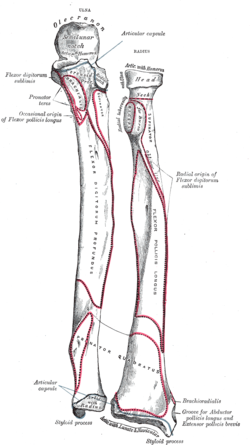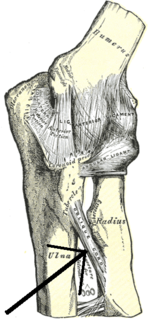
The humerus is a long bone in the arm that runs from the shoulder to the elbow. It connects the scapula and the two bones of the lower arm, the radius and ulna, and consists of three sections. The humeral upper extremity consists of a rounded head, a narrow neck, and two short processes. The body is cylindrical in its upper portion, and more prismatic below. The lower extremity consists of 2 epicondyles, 2 processes, and 3 fossae. As well as its true anatomical neck, the constriction below the greater and lesser tubercles of the humerus is referred to as its surgical neck due to its tendency to fracture, thus often becoming the focus of surgeons.

In anatomy, flexor carpi radialis is a muscle of the human forearm that acts to flex and (radial) abduct the hand. The Latin carpus means wrist; hence flexor carpi is a flexor of the wrist.

The radius or radial bone is one of the two large bones of the forearm, the other being the ulna. It extends from the lateral side of the elbow to the thumb side of the wrist and runs parallel to the ulna. The radius is shorter and smaller than the ulna. It is a long bone, prism-shaped and slightly curved longitudinally.
In anatomy, a styloid process, usually serving as points of attachment for muscles, refers to the slender, pointed process (protrusion) of:

The olecranon from the Greekolene meaning elbow and kranon meaning head is the large, thick, curved bony eminence of the ulna, a long bone in the forearm that projects behind the elbow. It forms the most pointed portion of the elbow and is opposite to the cubital fossa or elbow pit. The olecranon serves as a lever for the extensor muscles that straighten the elbow joint.

The inferior gluteal artery, the smaller of the two terminal branches of the anterior trunk of the internal iliac artery, is distributed chiefly to the buttock and back of the thigh.

The common interosseous artery, about 1 cm. in length, arises immediately below the tuberosity of the radius from the ulnar artery.

The deep artery of arm is a large vessel which arises from the lateral and posterior part of the brachial artery, just below the lower border of the teres major.

The posterior superior alveolar artery is given off from the maxillary, frequently in conjunction with the infraorbital artery just as the trunk of the vessel is passing into the pterygopalatine fossa.

The ischial tuberosity, also known informally as the sit bones, or as a pair the sitting bones is a large swelling posteriorly on the superior ramus of the ischium. It marks the lateral boundary of the pelvic outlet.
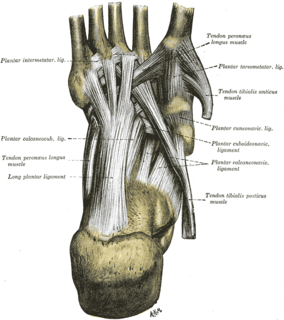
The long plantar ligament is a long ligament on the underside of the foot that connects the calcaneus with the cuboid bone.
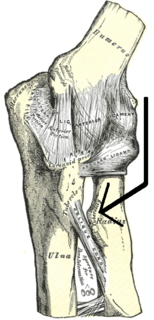
Beneath the neck of the radius, on the medial side, is an eminence, the radial tuberosity; its surface is divided into:

Behind the iliac fossa is a rough surface, divided into two portions, an anterior and a posterior. The posterior portion, known as the iliac tuberosity, is elevated and rough, for the attachment of the posterior sacroiliac ligaments and for the origins of the Sacrospinalis and Multifidus.

The styloid process of the ulna is found at distal end of the forearm, and projects from the medial and back part of the bone; it descends a little lower than the head, and its rounded end affords attachment to the ulnar collateral ligament of the wrist.

The perineal branches of the posterior femoral cutaneous nerve are distributed to the skin at the upper and medial side of the thigh.

Superior to the anterior portion of the trochlea is a small depression, the coronoid fossa, which receives the coronoid process of the ulna during flexion of the forearm. It is directly adjacent to the radial fossa of the humerus.
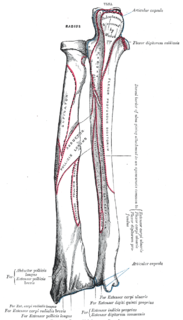
The head of the radius has a cylindrical form, and on its upper surface is a shallow cup or fovea for articulation with the capitulum of the humerus. The circumference of the head is smooth; it is broad medially where it articulates with the radial notch of the ulna, narrow in the rest of its extent, which is embraced by the annular ligament.
The public domain consists of all the creative works to which no exclusive intellectual property rights apply. Those rights may have expired, been forfeited, expressly waived, or may be inapplicable.

Gray's Anatomy is an English language textbook of human anatomy originally written by Henry Gray and illustrated by Henry Vandyke Carter. Earlier editions were called Anatomy: Descriptive and Surgical, Anatomy of the Human Body and Gray's Anatomy: Descriptive and Applied, but the book's name is commonly shortened to, and later editions are titled, Gray's Anatomy. The book is widely regarded as an extremely influential work on the subject, and has continued to be revised and republished from its initial publication in 1858 to the present day. The latest edition of the book, the 41st, was published in September 2015.
